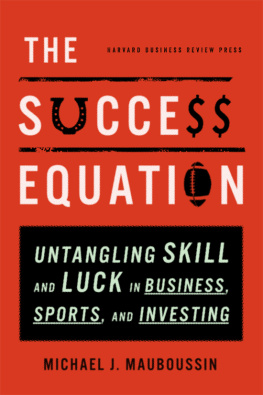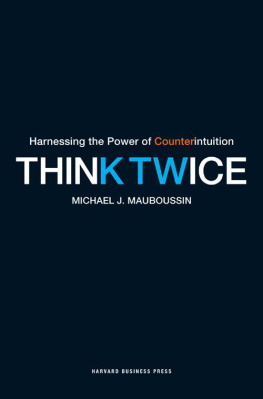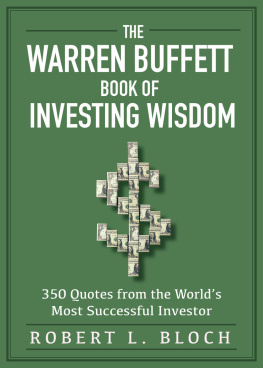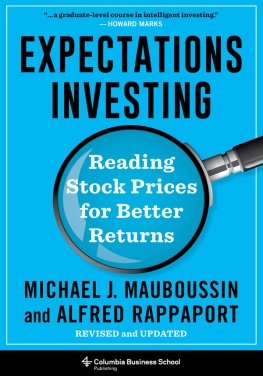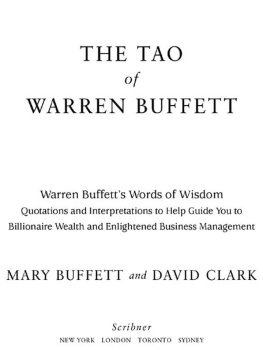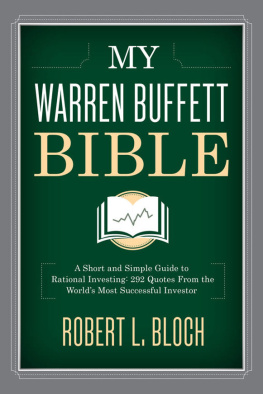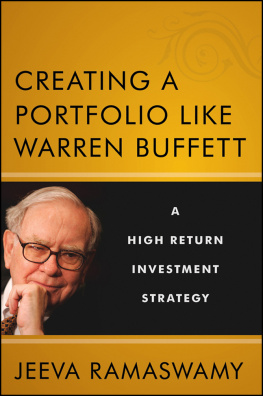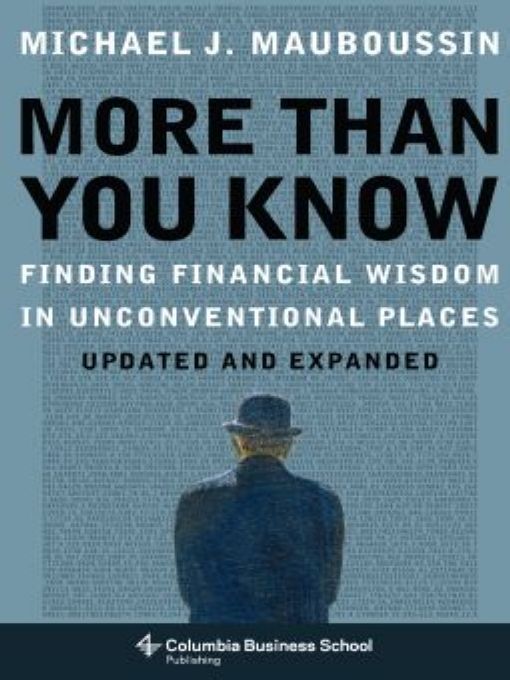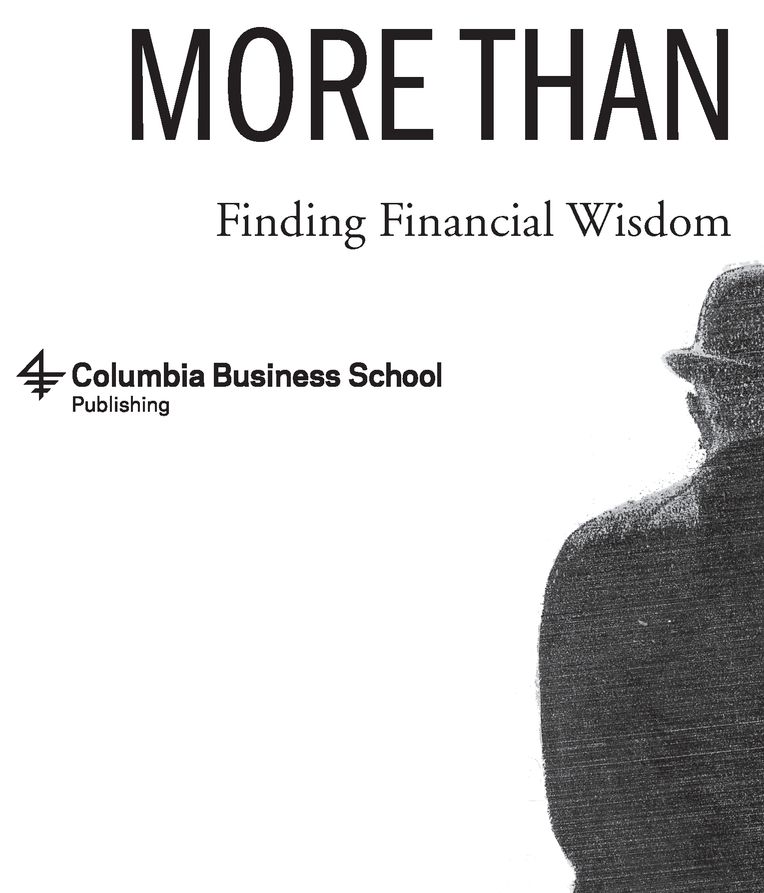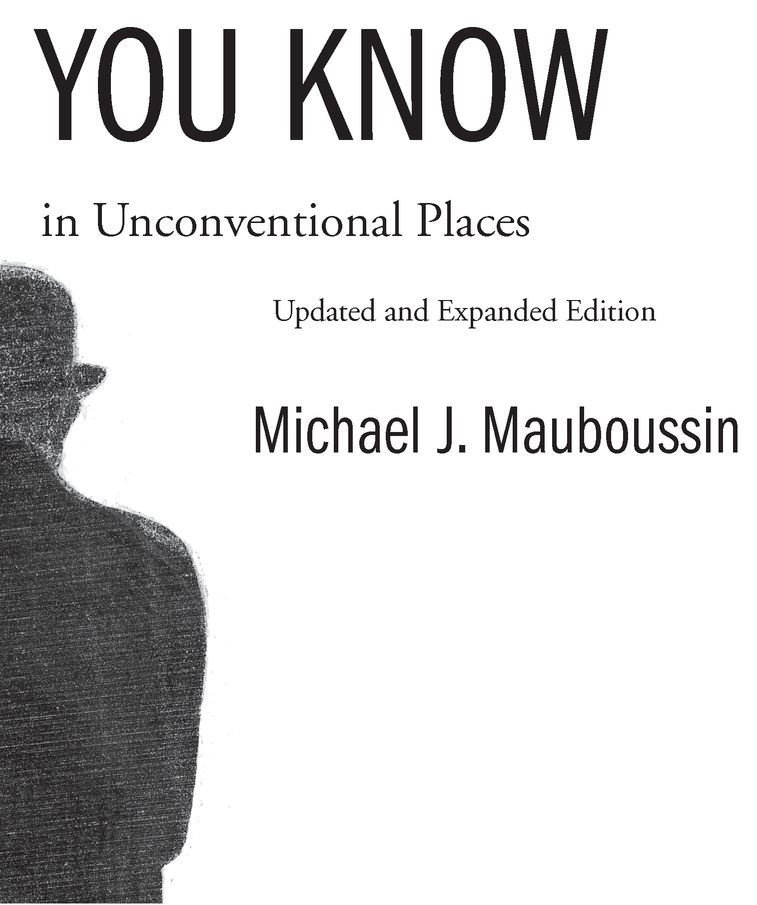Table of Contents
A balanced perspective cannot be acquired by studying disciplines in pieces but through pursuit of the consilience among them. Such unification will come hard. But I think it is inevitable. Intellectually it rings true, and it gratifies impulses that rise from the admirable side of human nature. To the extent that the gaps between the great branches of learning can be narrowed, diversity and depth of knowledge will increase.
Edward O. Wilson, Consilience
To my parents
Who always stood behind me but were never too close
ACKNOWLEDGMENTS
I wrote the original versions of these essays while I was at Credit Suisse (formerly Credit Suisse First Boston). In my dozen years at CSFB, management consistently offered me marvelous opportunities for professional development. Allowing me to launch The Consilient Observerthe offbeat offering that provided the basis for More Than You Knowis a tribute to the firms open-mindedness and support. In particular, I am indebted to Brady Dougan, Al Jackson, Terry Cuskley, Steve Kraus, and Jim Clark. Credit Suisse was also gracious in granting me the copyrights to these works.
Two names were listed on The Consilient Observers original masthead. The other belonged to my research associate, Kristen Bartholdson, who made significant contributions in research, editing, number crunching, and producing exhibits. She also helped update material for this edition. Smart and talented, Kristen is also a delightful person to work with.
Dan Callahan, my research associate at Legg Mason Capital Management, picked up where Kristen left off, working tirelessly on all aspects of this book. He was instrumental in updating the material for both editions, getting the exhibits and manuscript in shape, and coordinating all communication. Dan is resourceful, productive, and bright. Hes also a great guy, and Im really pleased he is on my team.
All of my coworkers at Legg Mason Capital Management have been terrific, providing valuable support and cooperation. LMCM also allowed me to use copyrighted material. Thanks to all of you.
Two people have had a major professional influence on me. The first is Al Rappaport, with whom I wrote Expectations Investing. I have learned an enormous amount from Al, and he remains a tremendous source of inspiration and constructive feedback.
The other is Bill Miller, whom I now have the honor of calling a colleague. Bill stimulated many of the ideas in these essays, either directly or indirectly. Its one thing to write about how the mental-models approach helps investors, its quite another to use the approach to generate excess returns. Bill has done both, and for that he deserves all of the admiration he receives.
Both Al and Bill have always been gracious with their time, and have taught me with patience. They are great role models, and I feel privileged to be associated with both of them.
These essays draw from the work of many fabulous scientists, too many to list individually. But a handful of thinkers deserve special mention, including Clayton Christensen, Paul DePodesta, Norman Johnson, Scott Page, Jim Surowiecki, and Duncan Watts. Thanks to each of you for sharing your ideas with me so generously. Steve Waites suggestions were also of great benefit to me.
Id like to thank Myles Thompson, my publisher and editor at Columbia University Press, for his boundless enthusiasm and unwavering belief in the power of these ideas. Assistant editor Marina Petrova has also been an immense help in all aspects of the project. Michael Haskell improved the books flow with his thoughtful edits and supplied the new, comprehensive title. Nancy Fink Huehnergarth was instrumental in shaping the original manuscript, providing both valuable editorial input and a fantastic sense of humor.
I also appreciate Sente Corporations very talented Jay Smethurst and Bryan Coffman for their artistic contributions. They were with me from the very beginning of the consilient journey. At CSFB, Marian Toy and Ann Funkhouser were great editors to work with: efficient, constructive, and thoughtful. My administrative assistant at CSFB, Melissa Little, also helped in key areas such as exhibit production and distribution.
My wife, Michelle, is a constant source of love, support, and counsel. My mother-in-law, Andrea Maloney Schara, is the rare grandmother who can explain systems theory and throw a football. Finally, I thank my children Andrew, Alex, Madeline, Isabelle, and Patrick for allowing me to see diversity firsthand.
INTRODUCTION
More Than You Knows core premise is simple to explain but devilishly difficult to live: you will be a better investor, executive, parent, friendpersonif you approach problems from a multidisciplinary perspective. Its the difference between moving into a fixer-upper home with a full set of power tools versus a simple screwdriver. You are going to be a lot more successful and efficient if you have the proper tool for each job at hand.
The reality is that the majority of us end up with pretty narrow slices of knowledge. Most occupations encourage a degree of specialization, and some vocations, like academia, insist on it. And there are the time constraints. We are all so busy talking on the phone, answering e-mails, and going to meetings that we dont have any time left to read, think, and play with ideas.
Following the publication of this books first edition, a lot of readers contacted me to say they enjoyed the exposure to non-traditional ideas. Most people easily appreciate the value of diverse thinking. But many readers view diversity as something thats nice to have, not something thats essential to success. In contrast, I have come to believe cognitive diversity is crucial to solving complex problems.
The case for cognitive diversity is based on theory and practice. In his book The Difference, social scientist Scott Page demonstrates the logic of diversity. He shows, using mathematical models, how and why diversity is necessary to solve certain types of problems. Page deftly nudges the diversity discussion away from metaphor and anecdote toward grounded, timeless theorems.
Notwithstanding Pages theoretical contribution, you might ask whether theres any actual evidence for diversitys value in predicting the outcomes of complex problems. The answer, a resounding yes, is based on psychologist Phil Tetlocks remarkable research summarized in his book Expert Political Judgment. Tetlock asked hundreds of experts to make thousands of predictions about economic and political events over a fifteen-year span. He then did something quite rude. He kept track of their results.
Expert forecasters were, on balance, deeply unimpressive. But Tetlock found some were better than others. What separated the forecasters was how they thought. The experts who knew a little about a lotthe diverse thinkersdid better than the experts who knew one big thing.
Two sources in particular have inspired my thinking on diversity. The first is the mental-models approach to investing, tirelessly advocated by Berkshire Hathaways Charlie Munger. The second is the Santa Fe Institute (SFI), a New Mexico-based research community dedicated to multidisciplinary collaboration in pursuit of themes in the natural and social sciences.


